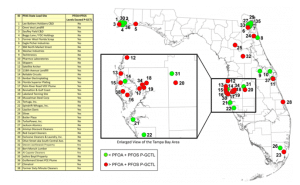 Contributed by Trey Hess P.E., Director of Brownfields and Economic Development, PPM Consultants
Contributed by Trey Hess P.E., Director of Brownfields and Economic Development, PPM Consultants
We have published a good number of blog posts related to PFAS over the last several months; and as a former regulator, I tend to focus more on the actions and plans that have been developed by the State regulatory agencies since most of the boots-on-the-ground work will be done on that level. In March 2022, the Florida Department of Environmental Protection (DEP) prepared their “PFAS Dynamic Plan” as a coordinated approach to addressing the breadth and depth of issues associated with per- and polyfluoroalkyl substances (PFAS). Here’s a summary of the initial plan along with some important updates since its adoption in 2022.
Background
PFAS are a diverse and complex class of synthetic chemicals that exhibit resistance to heat, water, and oil. Since the 1940s, PFAS have been extensively utilized in various consumer products, including stain and water repellents in textile manufacturing, paper products, food packaging, and cookware. These chemicals have also been integral to numerous industrial processes, such as the formulation of fire suppressant foams used at firefighting training facilities, airports, chemical plants, and military installations.
PFAS are known to bioaccumulate in both animals and humans, with evidence indicating that exposure to these substances can lead to adverse health effects. Despite extensive research, our understanding of PFAS and their impact on human health remains incomplete, and regulatory and technical developments regarding these chemicals are rapidly evolving. Once released into the environment, PFAS are highly persistent and easily migrate, leading to their classification as Contaminants of Emerging Concern (CEC). CECs are newly detected environmental chemicals that may pose public health or ecological risks, and the science concerning these substances, particularly PFAS, is advancing swiftly.
The widespread use of PFAS has resulted in the contamination of groundwater resources in Florida, affecting both private and public potable supply wells. DEP investigations have identified PFAS contamination at various sites, including fire training facilities, State Funded Cleanup sites, and Drycleaning Solvent Cleanup Program sites. Additionally, PFAS contamination has been detected at current and former federal facilities within the state.
FDEP’s PFAS Dynamic Plan
The PFAS Dynamic Plan is designed to establish a comprehensive strategy while acknowledging the need for adaptability as scientific understanding of these emerging contaminants evolves. The plan outlines the development of screening and provisional cleanup target levels that ensure the protection of human health and Florida’s environmental resources. It consolidates data and insights from previous and ongoing investigations to support proactive measures against potential PFAS contamination of drinking water resources. Future investigations will be risk-based and will involve continued collaboration with the Florida Department of Health (DOH) to promptly evaluate and address any impacts on drinking water resources.
Dynamic Plan Objectives
- Continue to be a national leader in response to PFAS concerns and to protect Florida’s communities from PFAS exposure.
- Provide a technical and regulatory framework for the development of screening and cleanup target levels for the protection of human health and the environment.
- Implement a response strategy to minimizes risks to human health and protects Florida’s natural resources.
- Identify PFAS contamination though site investigations.
- Continue efforts to prevent/reduce further impacts through outreach and communication.
- Continue efforts to identify areas of potential or known contamination and address environmental impacts through risk mitigation and remediation.
Actions Taken by DEP
Regulatory and Scientific Developments
DEP aims to be a national leader in PFAS response, protecting communities from exposure. The department has the authority to enforce cleanup and remediation efforts under state law. Coordination with state and federal agencies enhances the DEP’s capabilities in managing PFAS.
Coordination with State and Federal Agencies
DEP collaborates with various agencies, including the EPA, Department of Defense, and Florida Department of Health (DOH), to share information and best practices. This coordination includes data sharing, joint research projects, and developing health advisories.
Research and Technical Advances
DEP is actively investigating PFAS impacts through laboratory analysis and developing health advisory levels based on EPA guidelines. The DEP laboratory has enhanced its capabilities to analyze multiple PFAS compounds in water and soil, supporting ongoing assessment efforts.
Development of Health Advisory Levels
In 2022, the EPA and DOH established a lifetime drinking water health advisory level for PFOA and PFOS of 70 nanograms per liter. This level has guided local officials in evaluating drinking water safety and responding to contamination.
DEP Laboratory Capabilities
DEP’s laboratory, equipped with advanced instrumentation, can analyze 36 PFAS compounds in water and soil. The laboratory’s methods are consistent with EPA guidelines, ensuring accurate and reliable results.
DEP Contaminated Media Forum
The DEP engages with stakeholders through the Contaminated Media Forum, discussing provisional cleanup target levels and best practices for PFAS management. Feedback from these forums helps refine the department’s strategies.
University Research Projects and Case Studies
Several research projects are underway at Florida universities, supported by the Hinkley Center and EPA. These projects focus on PFAS prevalence, environmental transport, and remediation technologies. Studies include surface water sampling, solid waste stream impacts, and soil treatment technologies.
Contracted Toxicological Support
DEP collaborates with the University of Florida’s Center for Environment and Human Toxicology to develop and update provisional screening and cleanup target levels for PFAS, ensuring actions are based on the latest scientific understanding.
Development of Provisional Cleanup Target Levels
DEP has established provisional groundwater and soil cleanup target levels for PFOA and PFOS, guiding remediation efforts at contaminated sites. These levels are enforceable under state law, ensuring compliance with health and environmental standards. The calculations were completed in accordance with Chapter 62-777, Florida Administrative Code (F.A.C.), equations and methodology. The P-GCTLs for PFOA and PFOS concentrations are 70 nanograms per liter (ng/l), and 70 ng/l for the sum of PFOA and PFOS concentrations.
Addressing and Mitigating Exposures
Coordination with Florida Department of Health
DEP and DOH coordinate on PFAS assessment efforts, conducting well surveys and sampling private wells in areas of concern. The Water Supply Restoration Program provides alternative water supplies to affected well owners.
Identification and Site Investigation
DEP continues to assess suspected PFAS contamination sites, prioritizing areas based on risk. Investigations include public well systems, fire training facilities, dry cleaning sites, and state-funded cleanup sites. DEP’s Waste Cleanup Program conducted a statewide survey of thirty-eight (38) waste cleanup sites that are undergoing state funded cleanup. The purpose of this survey was to gather information regarding whether Per-and polyfluoroalkyl substances (PFAS) could be a contaminant of concern at these facilities. These facilities range from former landfills, metal plating facilities, chemical manufactures, electroplaters, and users of various solvents. The figure below shows the location of the 38 State funded sites that were sampled or will be sampled and the initial sampling results.

Outreach and Communication
DEP actively communicates its PFAS efforts through public notifications, educational materials, and maintaining an up-to-date website. The department collaborates with federal agencies to address PFAS contamination at military installations and other federal facilities.
Future Areas of Investigation and Emerging Issues
DEP is identifying new potential PFAS sources and addressing challenges in PFAS investigation and remediation. Emerging issues include developing analytical methods, managing investigation-derived waste, and improving remediation technologies.
Technical Developments
DEP is tracking PFAS knowledge development, participating in workgroups, and supporting research projects to enhance its technical understanding and operational procedures. Ongoing efforts include evaluating PFAS impacts on air quality, ecological risks, and refining cleanup criteria.
In summary, the DEP’s dynamic plan provides a comprehensive framework to address PFAS contamination in Florida, leveraging regulatory authority, scientific research, and interagency collaboration to protect public health and the environment. The plan is designed to adapt to evolving scientific understanding and emerging challenges, ensuring effective management of PFAS risks. If you have questions related to PFAS and how they might impact your community or your business operations, reach out to PPM so we can help you “simplify the complex.”

